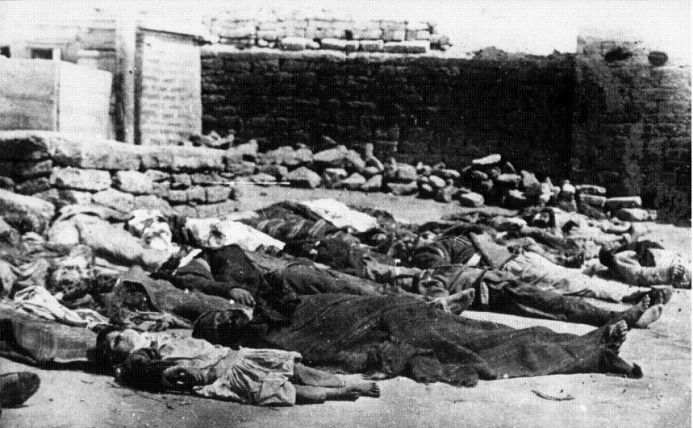Century passes since Genocide of Azerbaijanis

By Rashid Shirinov
Today Azerbaijan commemorates one of the bloodiest pages of its history – the Day of Genocide of Azerbaijanis, which was committed by Armenian nationalists exactly a century ago, on March 31, 1918.
In the early 20th century, Armenian nationalists expanded their activities towards the idea of a "Great Armenia" put forward by the “Dashnaktsutyun” Party, systematically expelled Azerbaijanis from their historical lands and native homes and embarked on a policy of ethnic cleansing and genocide. For example, in 1905-1906 the Armenians committed massacres against Azerbaijani civilians in Baku, Ganja, Karabakh, Irevan, Nakhchivan, Ordubad, Sharur-Daralayaz, Tiflis, Zangezur, Gazakh and other places, perpetrated ruthless massacres against the local population, burned and destroyed cities and villages. Armenian armed forces destroyed more than 200 Azerbaijani villages in Shusha, Zangezur and Jabrayil region, Irevan and Ganja provinces, expelling tens of thousands of Azerbaijanis from their homes.
After the developments that occurred in Russia in February and October of 1917, the “Dashnaktsutyun” Party and the Armenian National Congress launched even wider activities against Azerbaijanis. In 1918, whilethe entire world was involved in the World War I, the Armenian armed brigades, using the prevailing anarchic situation in the region, attempted to exterminate the Azerbaijani nation throughout the territory of Azerbaijan and present-day Armenia, and subsequently to establish an Armenian state on the Azerbaijani lands. Fortunately, the dedication of Azerbaijanis and the formation of self-defense groups did not allow this to happen.
The Armenians started with Baku and its environs. More than 12,000 Azerbaijani civilians living there were killed only because of their ethnicity. People were burned in their homes, tortured and killed with unparalleled cruelty. Armenian bandits collected corpses in the courtyard of Taza Pir mosque in Baku and lit a bonfire with them.
Anatoly Kvasnik, a Baku Jew who witnessed the genocide in the city, wrote in his testimony: "The organized bloody conspiracy of Armenians against the Muslim population was aimed to physically destroy them first in Baku and then in the outskirts, capturing all their property and moving all their natural wealth and political dominance in the hands of the Armenians."
Bloody events soon spread out covering the entire territory of Azerbaijan. In March-April 1918, about 8,000 civilians were slaughtered in Shamakhi. Armenian gangs stormed the city, setting houses on fire. Those who were trying to escape from the fire, were shot. The majority of Muslim monuments of culture, including the Friday Mosque of Shamakhi, were set on fire and burnt to the ground with elderly, women and children hiding in it. People were buried alive, while some were brutally tortured before being killed.
Moreover, Armenian nationalists killed with utmost cruelty more than 16,000 people in Guba province in the first five months of 1918. The facts of mass extermination of the Azerbaijanis of Guba by Armenian-Dashnak gangs were proven again in the 21st century – the discovery in 2007 of mass graves in Guba is a fact confirming the Armenian brutality. The study of the burial site revealed that people were subjected to unprecedented violence and killed with cruelty during the Armenian armed attack on Guba in 1918.
A ruthless massacre of the Azerbaijanis was also perpetrated in Shusha, Irevan, Zangezur, Karabakh, Nakhchivan, Kars and other regions. When committing these atrocities on historical Azerbaijani lands, the Armenians burned schools and mosques and destroyed samples of material culture of Azerbaijanis.
Shamakhi’s 58 villages were wiped off the face of the earth, as well as 112 villages in Guba, 272 in Ganja, 211 in the Irevan province, 82 in Kars and many other settlements. About a million people were driven from their ancestral lands.
After the proclamation of the Azerbaijani Democratic Republic on May 28, 1918, the newborn government investigated the March events. In 1919-1920, the ADR commemorated March 31 as the national day of mourning. Later, during the presidency of Heydar Aliyev in Azerbaijan, March 31 events were officially recognized as the Day of Genocide of Azerbaijanis, according to the presidential decree in 1998.
"Remembering the tragic events of 1918 is extremely important, primarily because the aggression of Armenians against Azerbaijani people continues to this day," says Natig Mammadzada, head of the History of the Genocide of Azerbaijani People Department of the Institute of History of Azerbaijan's National Academy of Sciences.
He reminded that Armenian nationalists repeated the extermination of Azerbaijanis in February 1992, during the Nagorno-Karabakh war, in the Azerbaijani town of Khojaly.
"The comprehensive peace between Azerbaijan and Armenia must necessarily guarantee today's and future generations of Azerbaijanis the impossibility of repeating the tragic events like those that took place in the spring of 1918 and subsequently occurred during the Karabakh war," Mammadzada noted.
A century ago Armenian terrorists committed atrocities of such brutality and viciousness that words cannot fully describe them. These violent and inhuman actions should never be forgotten and can never be justified. The world community has to remember and keep the memory of the genocide of 1918.
---
Rashid Shirinov is AzerNews’ staff journalist, follow him on Twitter: @RashidShirinov
Follow us on Twitter @AzerNewsAz
Here we are to serve you with news right now. It does not cost much, but worth your attention.
Choose to support open, independent, quality journalism and subscribe on a monthly basis.
By subscribing to our online newspaper, you can have full digital access to all news, analysis, and much more.
You can also follow AzerNEWS on Twitter @AzerNewsAz or Facebook @AzerNewsNewspaper
Thank you!
